Tag Archive: deafblind
March 24, 2019
by Carole Zangari -
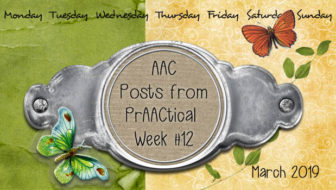
Happy Sunday, AAC friends! Here’s what we’ve been up to. Monday – PrAACtical Resources: Communication with Children with Deafblindness or Visual and Multiple Impairments Tuesday – AAC Link Up Wednesday – Video of the Week: AAC (Re)Boot Camp-It’s Not About the Technology Thursday – Using Generalization Probes to Gauge Language Learning in AAC :::::::::::::::::::::::::::::::::::::::::::::::::::::::::::::::::::::::::::::::::::::::::::::::::: We’ve been talking about AAC and book reading with some prAACtical friends this week. It seemed like a good time to share some book-related posts from the archives. 5 Ways to Use Books to Build Interaction with AAC Learners Alphabet Books and AAC Implementation Adapting Books with Visual Scenes Make It PrAACtical: Display Stand for Visual Supports or Books Using Adapted Books with AAC Learners: 3 Important Questions to Ask
Filed under: Featured Posts, PrAACtical Thinking
Tagged With: assessment, Books, data, data collection, deafblind
March 18, 2019
by Carole Zangari -
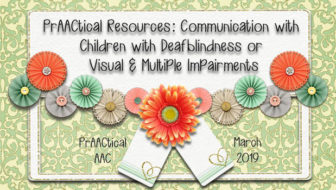
Many of us work with learners who have significant visual difficulties along with another disability such as hearing loss, autism, or intellectual disabilities. Today, we look at the Communication Resources from the Texas School for the Blind and Visually Impaired which is geared to helping teachers, therapists, and parents get familiar with some basic communication principles and instructional strategies. It includes sections on topics such as interaction/bonding, building security, play, calendars, and a video series by Sara Kitchener. Enjoy!
Filed under: Featured Posts, PrAACtical Thinking
Tagged With: deafblind, multiple disabilities, vision impairment
January 28, 2019
by Carole Zangari -
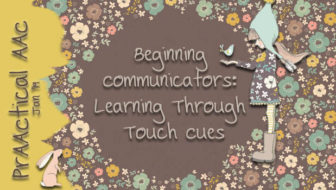
15-year-old Jodi has cerebral palsy and significant intellectual disability, among other things. In the most recent assessment of her motor, cognitive, communication, and self-help skills, scores ranged from 6-15 months. She spends most of her school day in her wheelchair. Jodi’s teacher affixes interesting toys to the lap tray so that she can explore them, but has become discouraged that Jodi mostly bangs them, puts them in her mouth, or tosses them to the floor. Her team struggles to find ways to teach Jodi to communicate more effectively. 10-year-old Nathaniel’s team notes that he shows little awareness of his classmates or teachers throughout the day, though he will smile and laugh when they take his hands and clap with him. As a younger child, he demonstrated more awareness of his surroundings but after his seizure activity spiked, it became more and more difficult to get him to engage. 6-year-old Jarrod... [Read More...]
Filed under: Featured Posts, PrAACtical Thinking
Tagged With: beginning communicator, deafblind, Touch Cues
June 21, 2017
by Carole Zangari -
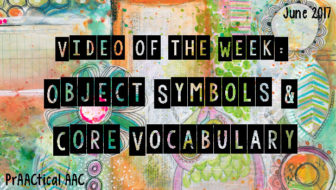
Figuring out the best way to represent language to someone who will be communicating through AAC is challenging, but when the client is unable to see well enough to use pictures, the task is infinitely more complex. In this week’s featured video, Dr. Kathy Howery provides an overview of the 3D tactile symbols created by the Center for Literacy and Disability Studies at the University of North Carolina Chapel Hill for high frequency core words. If you work with individuals who are blind or have very low vision, this important video is one you may want to share with the whole team. You can access the accompanying handout here. Many thanks to Kathy Howery and Edmonton Regional Learning Consortium for creating this video and making it available to us all.
Filed under: Video of the Week
Tagged With: blind, deafblind, low vision, object symbols, symbols
November 10, 2014
by Carole Zangari -
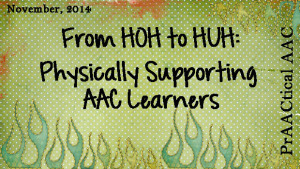
We’ve talked a lot about prompting strategies in previous posts, but today we look at one specific type: Physical assistance. Whether it is pointing to a symbol, activating the message window, turning pages in a communication book, or other early skills, beginning users of AAC often need a good deal of physical support to exhibit the desired behavior. Our first inclination may be to help the learner by using hand-over-hand (HOH) prompting, which is certainly effective in guiding them through the behavior. An even better way to support them, though, is hand-under-hand (HUH) prompting. With HUH, we guide learners by placing our hands under their hand (or just next to their hand) as we complete the desired behavior. HUH is frequently used with learners who have vision impairments and those who are deafblind. We find that it has much broader utility and can be a superior way of supporting some students... [Read More...]
Filed under: PrAACtical Thinking
Tagged With: beginning communiator, deafblind, dual sensory impaired, hand under hand, physical guidance, prompting
August 15, 2014
by Carole Zangari -
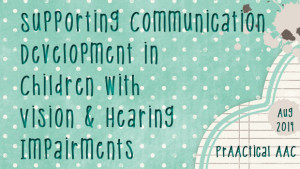
If you are new to working with young children who have both hearing and vision loss, this resource is for you. It is challenging it to complete meaningful assessments and to use those data to design effective interventions. This resource guide, edited by Dr. Charity Rowland, has wonderfully prAACtical information. In addition to the general content, there is specific information for SLPs, special educators, psychologists, and families. https://www.livebinders.com/media/get/NTEzMDI3OA==
Filed under: PrAACtical Thinking
Tagged With: beginning communicator, Charity Rowland, deafblind, hearing impairment, vision impairment
March 17, 2013
by Carole Zangari -
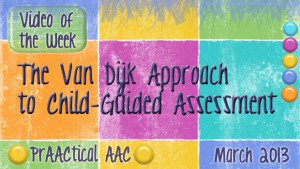
Getting good assessment information on learners with multiple disabilities, hearing, and vision loss is difficult, to say the least. Today we travel to the Netherlands to learn from Dr. Jan Van Dijk, who has pioneered an approach to working with individuals who have deafblindness. This series of webcasts, produced by Perkins School, discusses the theoretical underpinnings and practical aspects of the Van Dijk approach to child-guided assessment.
Filed under: Video of the Week
Tagged With: assessment, deafblind, hearing loss, multiple disabilities, Van Dijk, vision loss
January 6, 2013
by Carole Zangari -
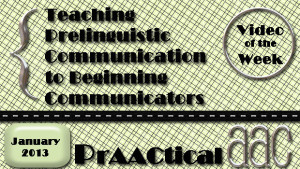
Although we are eager to get our AAC learners communicating with symbols, there are some times when we have to intervene at the prelinguistic level. Goals at this level center on communicating intentionally using overt behaviors, such as pointing, reaching, showing, and leading. We try to provide them with many opportunities to learn and practice these behaviors. Today, we’d like to share a set of brief videos from the website on Literacy for Children with Combined Hearing and Vision Loss. Because literacy develops from a good foundation in communication, the site demonstrates intervention designed to teach early communication skills. As you watch each of these videos, look for how the interventionist does these 7 things: Uses a context that is meaningful to the child Communicates warmly and enthusiastically, but does not overwhelm the learner Focuses on a single target behavior Uses language to label what is happening Provides physical guidance... [Read More...]
Filed under: Video of the Week
Tagged With: deafblind, hearing loss, prelinguistic, vision loss







